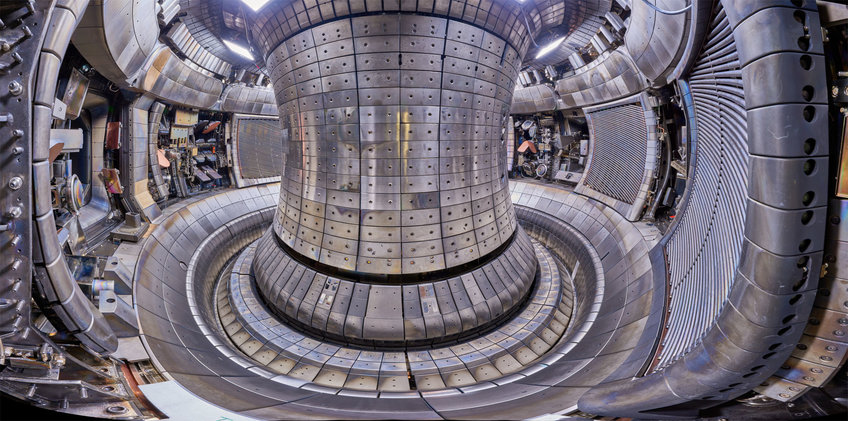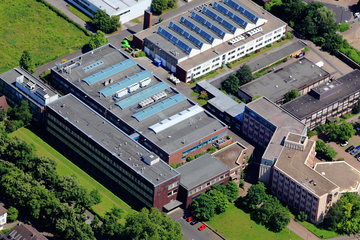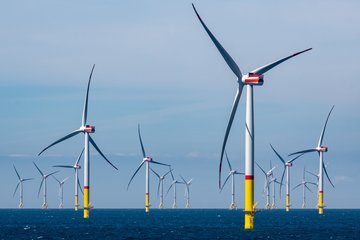Blueprint for a fusion power plant
On 21 March 1991, the Asdex Upgrade experimental facility at the Max Planck Institute for Plasma Physics in Garching generated the first plasma
For 30 years, the Asdex Upgrade has been paving the way for a fusion power plant that generates climate-neutral energy. The tokamak fusion plant was repeatedly expanded and improved during this time. Not least for this reason, it provides numerous insights that are incorporated into the design and operation of other fusion plants. For example, the Asdex Upgrade team has developed scenarios for the operation of the Jet test plant in the UK and the Iter test plant in France as well as forecasts for a planned demonstration power plant. A conversion planned for mid-2022 is intended to prepare the plant for the future.

The goal of fusion research is to develop a climate- and environment-friendly power plant. Like the sun, its purpose is to derive energy from the fusion of atomic nuclei. The fuel for this is an extremely thin, ionized hydrogen gas – a plasma. To ignite the fusion fire, the plasma must be enclosed in magnetic fields almost without contact and heated to over 100 million degrees.
In order to regulate the interaction between the hot fuel and the surrounding walls, scientists at the Max Planck Institute for Plasma Physics have equipped the Asdex Upgrade with a divertor, which has given the plant its name: Axial symmetric divertor experiment. Through an additional magnetic field, the divertor field removes impurities from the plasma and improves its thermal insulation.
However, in contrast to its predecessor Asdex, the Asdex Upgrade, the divertor and important properties of the plasma, especially the density and the load on the walls, are more closely adapted to the conditions in a later power plant. Equipped with a powerful plasma heater and sophisticated measuring equipment for observing the plasma, the Asdex Upgrade can therefore be used to develop operating modes for a potential power plant. In 38,700 plasma discharges to date, the plant has answered essential research questions for the European joint experiment Jet and the international experimental reactor Iter as well as a planned demonstration power plant.
A tungsten wall for the plasma vessel

With the Asdex Upgrade, the researchers took a significant step towards a future fusion power plant when they clad the wall of the plasma vessel with tungsten instead of carbon. Carbon has considerable advantages for experimental plants. However, it is unsuitable for the operation of a power plant because it is too strongly eroded by the plasma and binds too much fuel to itself. Because of its high melting point, tungsten is well suited as a wall material – at least in principle. But the plasma cools down quickly because of even the smallest impurities in the tungsten atoms that are repeatedly released from the wall. After a lot of experimentation, the Asdex upgrade team has been able to deal with this problem.
Direct consequences of this success: In a major rebuild, the European joint experiment Jet received a tungsten divertor in 2011. The international experimental reactor Iter team decided to forego the initially planned experiments with a carbon divertor and go straight for tungsten. Tungsten is also the reference material for the demonstration power plant.
Injecting hydrogen prevents instabilities
In the interaction of the charged plasma particles with the confining magnetic field, various disturbances of the plasma confinement can occur. These include instabilities at the plasma edge or ELMs (edge localized modes). In the process, the edge plasma briefly loses its confinement and periodically throws plasma particles and energy outwards onto the vessel walls. While medium-sized plants such as the Asdex Upgrade are able to cope with this, the divertor in large plants such as Iter could become overloaded. In order to solve this problem, procedures to prevent instabilities were developed for the Asdex Upgrade. Sixteen small magnetic coils in the plasma vessel completely suppress the instability with their fields. A second method starts at the outermost plasma edge. If the right plasma shape can be set – via the magnetic field – while ensuring a sufficiently high particle density – by injecting hydrogen – ELMs cannot develop.
Ensuring continuous operation
Continuous operation is guaranteed by fusion plants of the tokamak type – such as the Asdex Upgrade, Jet, or Iter – which construct the magnetic cage with two superimposed magnetic fields: a ring-shaped field generated by external magnetic coils and the field of a current flowing in the plasma. By combining the magnetic fields, the field lines are twisted in such a way that they enclose the plasma. The plasma current is normally induced in a pulse-wise manner by a transformer coil in the plasma. Unlike the more complicated stellarators, the entire system operates in pulses – a shortcoming of the tokamaks.
Scientists at the Max Planck Institute for Plasma Physics are therefore investigating various methods of continuously generating the current in the plasma. For example, by injecting high-frequency waves or particle beams that drive an additional current in the plasma. They have thus succeeded in operating the system almost without a transformer – and for the first time in a machine with a practically-relevant metallic inner wall. If the Asdex Upgrade had not been equipped with normally conducting copper coils but rather superconducting magnetic coils (as was the case for Iter), this phase could have been extended for much longer – potentially up to continuous operation.
What will happen next
During the 30 years of operation of the Asdex Upgrade, the divertor shape has been changed and optimized several times. The researchers now want to go a step further and test a new divertor concept. Two additional magnetic coils on the roof of the plasma vessel are intended to fan out the divertor field so that the power from the plasma is distributed over a larger area. Assembly of the coils is scheduled to begin in mid-2022. Such expansions will also enable future investigations at the Garching tokamak to solve the problems of a future demonstration power plant. “In many ways, the Asdex Upgrade can be seen as a blueprint for a tokamak fusion power plant”, says Project Leader Arne Kallenbach. “Together with newly developed computer codes, the sample discharges developed over 30 years provide reliable information for a power plant”.
IM/BA/PH












